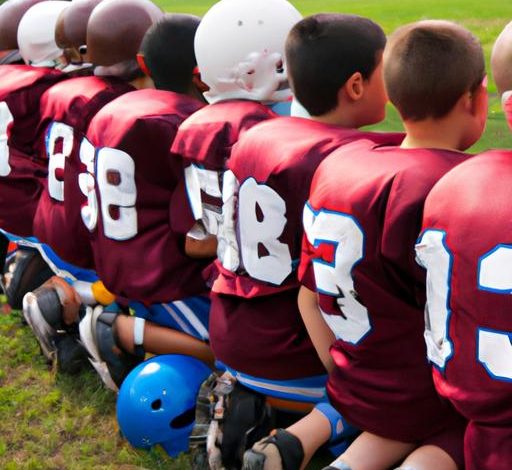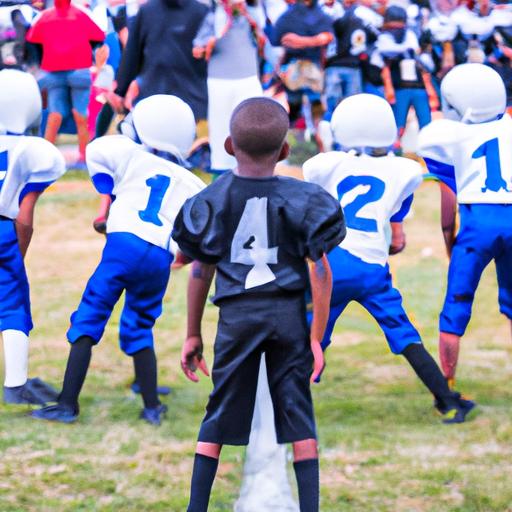How Long is a Youth Football Game?

If you’ve ever found yourself eagerly waiting on the sidelines, wondering how long you’ll be there cheering on your young football star, you’re not alone. Understanding the duration of a youth football game is essential for parents, coaches, and players alike. In this article, I will walk you through the factors that influence the length of a youth football game and shed light on the typical durations for different age groups. So, let’s kick off and dive into the exciting world of youth football!
A. Importance of Understanding the Duration of a Youth Football Game
Knowing the duration of a youth football game is crucial for planning your day and keeping everyone involved informed. As a parent, you may have other commitments, and understanding how long the game will last allows you to manage your schedule accordingly. Coaches can also strategize better, knowing how much time they have to work with during practice sessions and game plans. Additionally, players can pace themselves and ensure they have the stamina to give their best on the field.
B. Brief Overview of Youth Football Regulations
Before we delve into the game durations, it’s important to have a basic understanding of youth football regulations. The duration of a youth football game varies based on the age group and league regulations. Typically, youth football follows the same basic rules as professional football but with some modifications to accommodate the young athletes. These modifications include shorter game times, smaller fields, and adjusted rules to ensure safety and fair play.
Now that we understand the importance of game duration and have a grasp on the basic regulations, let’s explore the factors that influence how long a youth football game lasts.
Factors Influencing the Length of a Youth Football Game

When it comes to the duration of a youth football game, several factors come into play. Let’s explore these factors and understand how they influence the length of the game.
A. Age Group Distinctions
Different age groups in youth football have varying game durations. For instance, younger players in the flag football category, typically aged 5-7, may have shorter game times compared to older players in high school football, aged 14-18. The duration of the game is adjusted to suit the physical capabilities and attention span of each age group.
B. Quarter Lengths
Youth football games are divided into quarters, just like in professional football. However, the length of each quarter may differ depending on the age group. For example, younger players may have shorter quarters, while those in higher age groups may play longer quarters. These variations in quarter lengths contribute to the overall duration of the game.
C. Time-Outs and Breaks
Time-outs and breaks play a significant role in the duration of a youth football game. Coaches strategically use time-outs to discuss tactics, make substitutions, or provide guidance to their players. Additionally, there are scheduled breaks between quarters or halves, allowing players to rest and regroup. The frequency and duration of these time-outs and breaks can impact the overall length of the game.
D. Overtime Rules
In some cases, a youth football game may extend beyond its designated time if the scores are tied at the end of regulation play. Overtime rules come into effect to determine a winner. The duration of overtime periods can vary depending on the league’s regulations. These additional periods can add extra time to the game, prolonging its duration.
Understanding these factors that influence the length of a youth football game will help you better plan and enjoy the game. In the next section, we’ll delve into the typical durations of youth football games for different age groups.
Typical Duration of Youth Football Games

As mentioned earlier, the duration of a youth football game can vary depending on the age group and league regulations. Let’s take a closer look at the typical durations for different age groups and explore some factors that can influence the overall game length.
A. Duration for Different Age Groups
-
Flag Football (Ages 5-7):
Flag football games for the youngest players tend to be shorter to accommodate their attention spans and physical capabilities. On average, these games last around 30-45 minutes, including breaks. -
Pee Wee Football (Ages 8-10):
As players get a bit older, the game duration increases slightly. Pee Wee football games typically last around 60 minutes, divided into four quarters of 12-15 minutes each. -
Junior Football (Ages 11-13):
Junior football games start resembling the structure of high school football. The game duration is typically around 90 minutes, divided into four quarters of 15-20 minutes each. -
High School Football (Ages 14-18):
High school football games are the longest in terms of duration. They usually last around 120 minutes, divided into four quarters of 12 minutes each. However, the clock stops frequently, and the game can extend due to timeouts, penalties, and other factors.
B. Variations in Game Duration
-
Time Management by Coaches:
Coaches play a significant role in managing game duration. They strategically use timeouts, substitutions, and play calling to control the pace of the game. Efficient time management by coaches can help keep the game within the expected duration. -
Number of Penalties and Delays:
Penalties and delays can impact the overall duration of a youth football game. Frequent penalties and extended discussions between referees can prolong the game. Additionally, injuries and medical timeouts can also contribute to the game’s length.
Understanding the typical durations for different age groups and the factors that can influence game length allows players, coaches, and parents to prepare and adapt accordingly. In the next section, we will explore strategies to ensure efficient game progression and make the most of the allotted time.
Strategies to Ensure Efficient Game Progression
Efficiency is the name of the game when it comes to youth football. Coaches and teams can employ various strategies to ensure smooth and timely game progression. By implementing these strategies, the duration of a youth football game can be effectively managed, allowing everyone involved to make the most of their time on the field.
A. Pre-game Preparations
Before the game even begins, there are certain preparations that can contribute to efficient game progression. Coaches and team staff should ensure that the field is properly set up and all equipment is in working order. This includes checking the goalposts, field markers, and any other necessary equipment. By conducting these checks beforehand, any potential delays or interruptions during the game can be minimized or avoided altogether.
In addition to field preparations, team warm-ups and stretching play a vital role in getting players ready for the game. By properly warming up and stretching their muscles, players can reduce the risk of injuries and perform at their best. Coaches should allocate an appropriate amount of time for warm-ups, ensuring that it is efficient but still thorough enough to prepare the team adequately.
B. Effective Time Management During the Game
During the game itself, effective time management is key to maintaining a steady pace and avoiding unnecessary delays. Coaches can employ several strategies to ensure efficient game progression.
1. Quick Huddles and Play Calling
Encouraging quick huddles and efficient play calling can keep the game moving smoothly. Coaches can establish clear signals and concise play calls, allowing players to quickly understand their roles and execute the plays. Minimizing the time spent in huddles and maximizing the time spent on the field ensures that the game progresses at a steady pace.
2. Efficient Substitution Methods
Substitutions are a crucial part of youth football, allowing players to rest and ensuring that everyone gets an opportunity to contribute. Coaches should establish efficient substitution methods, such as designating specific players responsible for signaling substitutions or using planned rotations. By streamlining the substitution process, coaches can prevent unnecessary delays and keep the game flowing.
3. Timely Use of Time-outs and Breaks
Coaches should strategically use time-outs and breaks to their advantage, both for rest and game management purposes. By using time-outs strategically, coaches can regroup and adjust their strategies while minimizing the impact on the overall game duration. Additionally, breaks between quarters or halves should be utilized efficiently, ensuring that teams are ready to resume play promptly.
By implementing these strategies, coaches can optimize game progression and ensure that youth football games are both enjoyable and time-efficient. Efficient game management benefits everyone involved, allowing players, coaches, and parents to make the most of their time on the field.
Conclusion
Understanding the duration of a youth football game is essential for all those involved, including parents, coaches, and players. By being aware of the factors that influence the game length, everyone can better plan their schedules and make the most of their time on and off the field.
In this article, we explored the importance of knowing the duration of a youth football game and provided a brief overview of the regulations. We discussed how factors such as age groups, quarter lengths, time-outs, and overtime rules affect the game’s duration. Additionally, we examined strategies for efficient game progression and highlighted the impact of external factors like weather conditions, injuries, and referee decisions.
At Game Hoy, we understand the significance of game duration in youth football. Our aim is to provide you with the information you need to fully enjoy the game while respecting time constraints. Whether you’re a parent, coach, or player, we encourage you to embrace the excitement of youth football while being mindful of the clock.
Remember, time flies when you’re having fun, so make the most of every minute on the field. Stay engaged, cheer on your team, and create lasting memories. Game Hoy is here to support you in your youth football journey, ensuring you have a fantastic experience every step of the way.
Thank you for joining us on this exploration of how long a youth football game lasts. We hope you found this article informative and valuable. Keep the game alive, keep the spirit high, and enjoy every moment of youth football!
Stay tuned for more exciting content and helpful tips from Game Hoy!
Conclusion: So above is the How Long is a Youth Football Game? article. Hopefully with this article you can help you in life, always follow and read our good articles on the website: Game Hoy




